One of the most popular sources of artificial lighting is fluorescent lamps. They consume 5-6 times less energy than standard incandescent lamps, but at the same time they shine with the same brightness. LED luminaires with drivers are more economical, but due to their high cost, they have not succeeded in ousting fluorescent lamps (LDS) from the market. With prolonged use, fluorescent lamps may lose their functionality. You can fix such problems, but for this you need to know how to check a fluorescent lamp, including using a multimeter.
- The device and principle of operation of fluorescent lamps
- Causes of burnout of fluorescent lamps
- Digital tester check
- Troubleshooting and Troubleshooting
- Integrity of spiral electrodes
- Faults in electronic ballast
- How to check a fluorescent lamp choke
- How to check the starter
- How to check the capacitance of a capacitor with a tester
- Switching on a fluorescent lamp without a choke
- Burned-out lamps connection diagram
The device and principle of operation of fluorescent lamps
There is only one peculiarity here - visible illumination from the lamp arises only after the ultraviolet radiation is modified. Such a transformation is possible only when using those compounds that contain calcium halophosphate or other compounds with the presence of phosphors.
According to the principle of operation, LDS can be equated with gas-discharge type lighting sources. An inert gas is placed in a glass flask, after having evacuated air from it, and then 30 mg of mercury is added to the gas. Spiral electrodes, similar to a filament, are installed in both edges of the vessel. They are soldered on each side to 2 contact legs, which are placed in dielectric type plates. The inner surface of the tube is covered with a phosphor layer.
The daylight is switched on using a ballast - electromagnetic or electronic type. The electromagnetic device includes a main element - a choke. It is a ballast type resistor in the form of an inductive coil with a metal core, which is connected in series with a fluorescent lamp.
An inductor is needed to maintain a uniform discharge and adjust the current as needed. When the lamp turns on, the choke suppresses the starting current until the spiral filaments warm up, and then gives out the maximum voltage from self-induction, as a result of which the LDS is ignited.
Causes of burnout of fluorescent lamps
To extend the service life, a layer of active alkali metal is applied to the tungsten filament. The discharge between the electrodes is stabilized and the temperature drops, thanks to which the filament lasts much longer.
Frequent switching on / off of the lamp entails the destruction of the protective layer, it simply falls off. The discharge passing through the bare threads heats the spiral at weak points, as a result of which burnout occurs.
Digital tester check
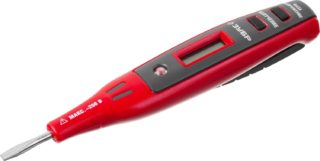
Using a digital tester, you can check the integrity of the filaments. This can be done both in the dial mode and in the resistance test mode. It is necessary to set the multimeter to the desired mode and check the spiral on both ends of the tube.
In the dialing mode, if the coil is working properly, the tester will give out a characteristic sound - a buzzer.
In the resistance test mode with a working coil, the multimeter indicator will display a value of 5-10 ohms.
Burnout of heating filaments is the most common breakdown of fluorescent lamps, which is easy to detect with a digital tester.
Troubleshooting and Troubleshooting
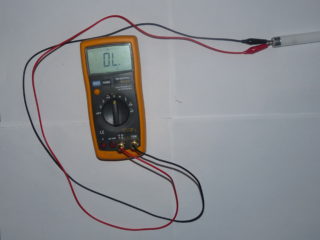
LDS is faulty in such cases:
- does not turn on;
- flickers temporarily before switching on;
- flickers for a long time, but does not turn on;
- buzzing;
- flickers when burning.
Integrity of spiral electrodes
You can ring the spiral electrode for the presence of resistance using a multimeter. The resistance measurement mode is set on the device, and after that the probes are applied to the legs of the flask on both sides.
If the coil is faulty, the multimeter will show zero resistance - the thread is broken. The whole coil always shows little resistance - up to 10 ohms. If at least one of the spirals is faulty, the lamp must be replaced. It cannot be restored.
Faults in electronic ballast
To check the health of the electronic ballast, it must be replaced with a working one. If the lamp lit up, then the cause of the breakdown was in it. Broken ballast can be repaired by yourself. First you need to change the fuse to a similar model with the same characteristics. If the filaments glow weakly, then there is a breakdown in the capacitor between them. It is also replaced by a similar one, but with an operating voltage of 2 kV. weak models will quickly burn out.
Transistors may burn out due to voltage surges. They need to be changed. You can take new ones from old ballasts. After replacement, it is necessary to check the fluorescent lamp with a 40 W lamp.
How to check a fluorescent lamp choke
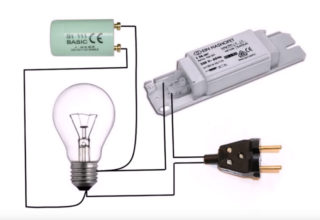
Before you check the fluorescent lamp choke with a multimeter, you need to familiarize yourself with the main signs of its breakdown:
- buzzing lighting fixture;
- the lamp turns on and goes out after a while, darkening at the edges;
- LDS overheats;
- "snakes" appear inside the tube;
- the lamp flickers a lot.
To check the throttle for operability, it is necessary to remove the starter from the lamp, and then close the contacts in its holder. Then the lamp is removed and the contacts in both sockets are also short-circuited. The multimeter is set to measure the resistance, after which its probes are connected to the contacts in the lamp holder. If there is a break, the device will show endless resistance. In case of turn-to-turn closure, the device will show zero value.
How to check the starter
If the lamp began to flicker immediately after switching on, but at the same time it did not light up, the starter was out of order. It will not work to dial it separately from the LDS, since without voltage its contacts are open.
Checking the health of the starter is possible by another method - by connecting it in series with an incandescent lamp to a standard power supply.
The main reason for failure is that the bimetallic plate wears out a lot.
How to check the capacitance of a capacitor with a tester
If the LDS capacitor is faulty, its efficiency rate decreases to 35-40%. For lighting devices with a power of no more than 40 W, a capacitor with a capacity of 4.5 μF is sufficient. If it is less than this norm, the efficiency will be reduced, if it is more, the lighting will blink.
To measure, the capacitor must be ringed with a multimeter. When the test leads touch the part outputs, the device demonstrates endless resistance. When this figure is less than 2 MΩ, this is a symptom of a significant leakage current.
Switching on a fluorescent lamp without a choke
A burnt-out fluorescent lamp can be returned to work if it is connected to the circuit with a constant voltage, excluding the starter and the throttle element. Using a full-wave voltage doubling rectifier will help here. If after a while the brightness of the lamp decreases, it must be turned over in the luminaire, as a result of which the connection poles will change.
This scheme assumes the use of radioelements with a voltage indicator of no more than 900 V. It is this value that the LDS reaches at startup.
Burned-out lamps connection diagram
Due to the burnout of the filaments, fluorescent lamps often become unusable. It is possible to return a second life to such a lamp using an unconventional starting scheme, which has been repeatedly tested by folk craftsmen.
From the table you can find out the nominal values of radioelements for LDS with different power. Limiting resistors R1 must be made of wire.
You can repair LDS at home if you follow the diagrams and follow certain instructions. This knowledge makes it possible to extend the operating period of the lighting fixture.

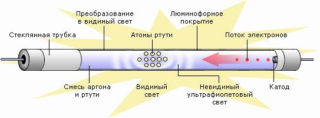
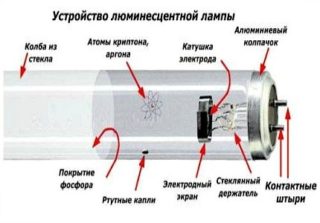










Fir trees, buy an LED tube and do not worry